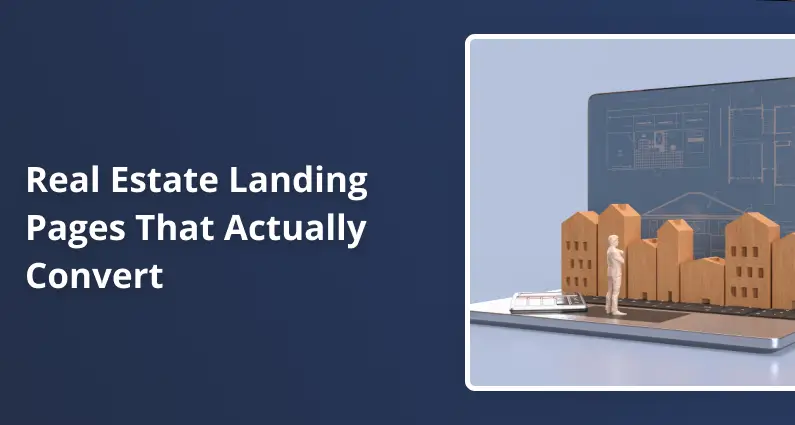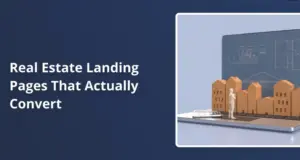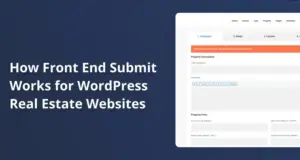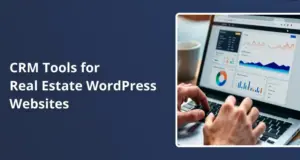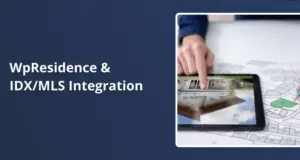You’ve spent money on Facebook ads. You’re running Google campaigns. Maybe you’re even posting consistently on Instagram. But here’s the problem: all that traffic is landing on your homepage, bouncing around, and leaving without giving you their contact info.
That’s where real estate landing pages come in. Unlike your main website, with its dozen menu options and multiple paths to explore, a landing page is refreshingly simple and focused: it has one job, and it does it well, turning visitors into leads.
It’s a single web page built around one specific action you want someone to take. There are no distractions, no navigation bar pulling attention away, just your offer and a clear next step.
Think of it this way. When someone clicks your ad about a free home valuation, they shouldn’t land on your generic homepage. They should arrive on a page that says “Get Your Free Home Valuation” with a simple form to fill out. That’s a landing page at work.
What Makes Real Estate Landing Pages Different
Your main real estate website serves multiple purposes. It showcases your listings, tells your story, maybe has a blog, and lets people explore different services. That’s fine for general browsing.
But when you’re running a targeted campaign, you need something different. Unbounce explains that landing pages work because they match the message that brought someone to your site. If your ad promised a buyer’s guide to downtown condos, your landing page should deliver exactly that, not a buffet of options.
The power is in the focus. Real estate landing pages remove every possible exit route except the one you want. No sidebar widgets. No footer links to your about page. Just the offer, the benefits, and a form or button.
This focused approach drives results. According to marketing research, pages designed around a single call-to-action convert significantly better than multi-purpose pages. You’re not asking visitors to make ten decisions. You’re asking them to create one.
Who Actually Uses Real Estate Landing Pages
Real Estate Agents
Individual agents and small teams use landing pages to capture leads from digital marketing. As The Close points out, more buyers start their home search online than ever before. You’re losing potential clients if you’re not converting that digital interest into actual contacts.
Here’s a practical example: Run a Facebook ad offering a neighborhood market report. When someone clicks, they land on a page with a headline like “See What Homes Are Really Selling For in [Neighborhood].” Below that, a short form asks for their email address. There is no navigation menu tempting them to browse listings, no blog posts about staging tips, just the report offer and the form.
This works because it maintains continuity. The ad made a promise, and the landing page delivers on that promise immediately, satisfying the visitor’s expectations and building trust.
Brokerages and Firms
Larger real estate companies use landing pages for campaigns and promotions. A brokerage might create a page for a new condo development they’re marketing, featuring renderings, amenity lists, and a form to schedule private tours.
The advantage for brokerages is segmentation. You can build different landing pages for different audiences. First-time buyers get one message and design, and luxury property investors get another. Each page speaks directly to that audience’s needs and concerns, making them feel targeted and understood.
Brokerages also use landing pages to build their email lists. Offer a comprehensive buyer’s guide or market forecast in exchange for contact information. Once someone’s on your list, you can nurture that relationship over time.
Property Developers
Developers rely heavily on landing pages for pre-construction marketing. When you’re selling units that don’t exist, your landing page becomes your showroom.
A developer might run ads for “VIP Early Access” to a new apartment building. The landing page showcases architectural renderings, highlights premium amenities, includes a location map, and features a form to join the VIP list.
The landing page sets expectations, especially for luxury developments. High-end buyers expect a polished presentation, and your landing page design needs to reflect the quality of the property you’re selling.
Building Real Estate Landing Pages in WordPress
WordPress handles landing pages exceptionally well. You don’t need a separate platform like Leadpages or Unbounce (though those work too).
Building directly in WordPress keeps everything under one roof, maintains consistent branding, and saves money on additional subscriptions.
WordPress can power your leading site and landing pages without any issues. The key is knowing how to set them up properly.
Setting Up the Page Structure
In WordPress, you’ll create landing pages as regular Pages (not Posts). Go to Pages > Add New for each campaign you want to run.
What makes it a landing page isn’t the content type. It’s how you configure it:
Remove Navigation Elements
Most WordPress themes let you select a page template. Look for options like “Blank Template,” “Full Width,” or “Landing Page Template.” These strip away your header menu, sidebar, and footer.
If your theme doesn’t offer this, any decent page builder plugin (we’ll cover those next) lets you hide navigation elements per page.
Why remove navigation? Because research shows that landing pages perform best when they “strip away navigation menus, sidebars, and other distractions to focus entirely on conversion.” Every link you include is another chance for visitors to leave without converting.
Focus on One Clear Action
Your landing page should ask for one thing. Not “sign up for our newsletter AND schedule a tour AND browse listings.” Pick one conversion goal:
- Download a buyer’s guide
- Request a home valuation
- Register for a property tour
- Sign up for market updates
- Schedule a consultation
Everything on the page should support that single goal.
Essential WordPress Tools for Landing Pages
Page Builders
Page builders let you design landing pages visually without touching code. Popular options include:
- Elementor: Drag-and-drop interface with tons of templates. The free version works fine for basic landing pages. The Pro version adds form builders and A/B testing.
- Beaver Builder: Clean interface, reliable performance. Good if you want something straightforward.
- SeedProd: Specifically marketed for landing pages and coming soon pages. Includes lead capture forms built in.
- Divi Builder: If you already use the Divi theme, its builder is powerful and includes many real estate-friendly modules.
Page builders speed up the process considerably. Instead of writing HTML and CSS, you’re clicking and dragging elements into place. You can see what you’re building in real-time.
According to WordPress documentation, these tools democratized web design by making it accessible to non-developers.
Form Plugins
If you are using WpResidence theme you already have a contact form builder that covers everything . If you are not using WpResidence (your loss.. 🙂 ) continue below…
You need a way to capture lead information. Built-in WordPress doesn’t handle forms well. That’s where form plugins come in:
- WPForms: User-friendly with a drag-and-drop form builder. Offers spam protection and email notifications. The Lite version is free and sufficient for basic lead capture.
- Gravity Forms: More powerful with conditional logic. Suitable for complex forms or multi-step registration processes.
- Contact Form 7: Free and lightweight. Requires more setup but gives you complete control.
- Ninja Forms: Another solid free option with paid extensions for advanced features.
Your form should be short. Every field you add reduces conversion rates. For most real estate landing pages, name and email are sufficient. You could add a phone number if that’s how you prefer to follow up. Don’t ask for 15 pieces of information upfront.
CRM Integration
Again .. WpResidence contact forms are integrated with Hubspot CRM and WpEstate CRM (that comes free with the theme). You may want to check that …
Once you capture leads, you need somewhere to store and manage them. Manual data entry doesn’t scale.
Look for plugins that connect your forms to your CRM:
- WP-CRMhttps://wordpress.org/plugins/wp-crm-system/ System: WordPress-native CRM that keeps everything in one place
- HubSpot for WordPhttps://www.hubspot.com/products/wordpressress: Connects forms directly to HubSpot CRM
- Zapier integZapier.comration: Connects WordPress forms to hundreds of tools, including Salesforce, Mailchimp, and real estate-specific CRMs
Connecting landing pages to your CRM allows for “seamless lead management and follow-up.” Without this connection, you’re manually entering data (which wastes time) or losing leads entirely.
Content Best Practices Within WordPress
WordPress makes it easy to follow landing page best practices:
Headlines That Grab Attention
Your headline appears at the top of the page. It should immediately communicate your offer—not clever wordplay, but clear communication.
Good examples:
- “Get Your Free Home Value Report in 60 Seconds”
- “Download the Complete Buyer’s Guide to [Your City]”
- “See This Luxury Lakeside Villa Before Anyone Else”
Bad examples:
- “Welcome to Our Website”
- “Real Estate Excellence”
- “Your Dream Home Awaits”
The bad examples are vague. The good ones tell you precisely what you’re getting.
Keep Copy Concise
You’re not writing a novel. Most visitors won’t read long paragraphs. Use the WordPress block editor to format text with:
- Short paragraphs (2-3 sentences max)
- Bullet points highlighting key benefits
- Subheadings to break up sections
- Bold text for emphasis (but don’t overuse)
Visual Quality Matters
Real estate is visual. Your landing page needs strong imagery. WordPress handles this well:
Upload high-resolution photos of properties or lifestyle images that connect emotionally. The block editor’s cover block works great for hero images with text overlays.
But compress images before uploading. Large files slow your page down. Tools like TinyPNG or WordPress plugins like Smush handle compression automatically.
Consistent Branding
Your landing page should look like it belongs to your company. Use your brand colors for buttons and headings. Include your logo (though maybe smaller than on your leading site).
WordPress theme customizers and page builders make this straightforward. Set your brand colors once, then apply them to any element.
Analytics and Tracking
You need to know if your landing page is working. Install Google Analytics using a plugin like MonsterInsights or by adding the tracking code to your theme.
Set up conversion tracking to measure form submissions. This tells you what percentage of visitors are converting. If you’re getting traffic but no conversions, something’s wrong with your page (confusing offer, weak headline, form asking for too much information).
Some real estate marketers run A/B tests by creating two landing page versions and splitting traffic between them. WordPress makes this easy since duplicating a page takes seconds.
Major Design Styles for Real Estate Landing Pages
Design isn’t just about looking good. It communicates trust, professionalism, and brand identity. Different styles work better for various audiences and property types.
Minimalist Style
Minimalist landing pages strip everything down to the basics. You get a bold headline, maybe one paragraph of text, and a form. That’s it.
The philosophy is “less is more.” By removing clutter, the core message stands out unmistakably. The is research that confirms that this approach increases focus on the call to action.
Visual characteristics:
- Lots of white space
- One or two colors max
- Simple, clean fonts
- Very little text
- Single prominent CTA button
When to use it:
This works well for straightforward offers. For example, if you’re running a lead magnet like “Enter Your Address for an Instant Home Value,” a minimalist design keeps things simple.
It also appeals to younger, design-conscious clients. A tech-savvy buyer looking at modern condos will appreciate a clean, uncluttered interface.
The challenge with minimalism is that every element needs to work hard. Your headline must be perfect, and your single image must communicate the right emotion. You don’t have room for filler.
Luxury Style
Luxury landing pages exude elegance and exclusivity. They’re designed for high-end properties and affluent clients.
Visual characteristics:
- High-quality, professional photography
- Sophisticated color schemes (black, white, gold, navy)
- Refined typography mixing serif and sans-serif fonts
- Plenty of space between elements
- Subtle animations or parallax scrolling
Luxury real estate design must “reinforce trust, credibility, and exclusivity” with every choice.
When to use it:
Marketing multi-million dollar properties requires a landing page that matches the product quality. A developer selling penthouse units can’t use a basic template. The page needs to feel as premium as the real estate.
This style also works for agents branding themselves as luxury specialists. Even if the specific property isn’t ultra-high-end, the luxurious presentation positions you as someone who operates in that market.
The key is balance. Luxury doesn’t mean busy. You want opulence communicated through quality, not quantity. One stunning photograph beats a dozen mediocre ones.
Modern Style
Modern landing pages project contemporary innovation. They use current design trends and feel cutting-edge.
Visual characteristics:
- Clean geometric layouts
- Card-based content sections
- Bold, oversized typography
- Flat design icons
- Interactive elements (hover states, scroll animations)
- Striking accent colors against neutral backgrounds
Modern designs often use modular grids and clear interactive feedback, making the interface sleek and responsive.
When to use it:
This appeals to tech-savvy audiences and works well in trendy urban markets. Modern design signals you’re forward-thinking if you’re advertising a new home-search app, a property tech service, or condos in a hip neighborhood.
Modern style “signals innovation and forward-thinking,” attracting clients who value fresh approaches over traditional methods.
It also doesn’t mean flashy gimmicks. It means using contemporary design principles to create an engaging, easy-to-use experience.
Traditional Style
Traditional landing pages have a classic, familiar look. They’re the digital version of a firm handshake and business card.
Visual characteristics:
- Serif or classic fonts
- Formal layouts with clearly defined sections
- Conservative color schemes (blues, grays, deep reds)
- More text content than modern alternatives
- Professional imagery (staged homes, local landmarks)
- Prominent display of credentials and awards
So, traditional design “communicates stability, trustworthiness, and adherence to established norms.”
When to use it:
This works for established brokerages and agents targeting traditional markets. If your clients are older homeowners or you operate in a small town where reputation matters more than trends, traditional design communicates reliability.
A family-run brokerage that has been advertising since 1985 should probably use traditional styling. It reinforces the “trusted local expert” positioning.
If you push too far, you risk looking outdated. The goal is “timeless professional,” not “stuck in 2005.” Use classic elements, but keep the layout clean and readable.
Image-Heavy Style
Image-heavy pages allow photographs to communicate most of the time. Text is minimal. Visual storytelling takes center stage.
Visual characteristics:
- Large, full-screen background images or slideshows
- Gallery grids of clickable photos
- Minimal text overlays
- Focus on lifestyle and atmosphere
- Short captions or no text at all
Using imagery to tell stories “can convey emotion and information faster than text,” especially in visual industries like real estate.
When to use it:
This style shines when your photos are your best-selling point. Luxury property developers showcase stunning architectural renderings, and vacation real estate marketers display beachfront views and pools.
Let those images do the work if you’ve got professional photography of beautiful properties. A grid of gorgeous living spaces speaks louder than paragraphs about square footage.
The challenge is page speed. Multiple high-resolution images can significantly slow load times. Use WordPress plugins that implement lazy loading (images only load as users scroll down) and cmpress all images without sacrificing quality.
Bold Style
Bold landing pages make a strong visual impact. They stand out with vibrant colors, attention-grabbing graphics, and unconventional layouts.
Visual characteristics:
- Vibrant, contrasting color schemes
- Oversized typography
- Graphic elements and illustrations
- Breaking the grid intentionally (overlapping sections, diagonal layouts)
- High-energy, urgent messaging
The goal is to be memorable and convey confidence.
When to use it:
This works for campaigns that need to create buzz or urgency. Pre-construction condos in trendy neighborhoods, limited-time seminar registrations, anything where you want to communicate “this is different” or “act now.”
A modern brokerage that differentiates itself from traditional competitors might use bold design to reinforce its brand message. You’re saying, “We don’t do things the old way.”
But bold doesn’t mean messy. The colors might be loud, but the layout should still be organized. The message must remain clear even when the visuals are attention-grabbing.
Optimizing Performance for Conversions
Even the best-designed landing page fails if it loads slowly or breaks on mobile devices.
Speed Matters
Google research shows that bounce rates increase dramatically with load time. If your page takes five seconds to load, you’ve already lost a chunk of potential leads.
WordPress optimization strategies:
- Use a caching plugin (WP Rocket, W3 Total Cache)
- Compress and optimize all images
- Minimize plugins (only use what you actually need)
- Choose quality hosting (shared hosting often slows WordPress sites)
- Enable lazy loading for images.
Mobile Responsiveness
More people browse real estate on phones than on desktops, so your landing page must work perfectly on small screens.
Most WordPress themes and page builders handle responsive design automatically. But test it yourself. Load the page on your phone. Does the form work? Are buttons easy to tap? Can you read the text without zooming?
Form Simplicity
Every extra form field reduces conversions. You’re asking too much if you’re asking for name, email, phone, address, property type, price range, and preferred contact method.
Start with name and email. That’s enough to begin a conversation. After you’ve established trust, you can gather more information.
Building Real Estate Landing Pages with WPResidence
Page Templates
WPResidence provides a “Blank Page” template that removes your site’s header, navigation, and footer. Please select it from Page Attributes when creating a new page. You can also use Elementor’s “Canvas” template to achieve the same effect.
You can control headers and footers globally through Theme Options → Header/Footer Settings and then override them on individual pages as needed.
Elementor Widgets
WPResidence includes over 50 custom Elementor widgets for real estate:
Property widgets: Property Slider, Property Grid, Property Search Form, Recent Properties, Property Hero
Lead capture: Contact Form, Contact Agent, Lead Form, Call-to-Action Banner
Content: Image Slider, Testimonial Carousel, Agent Info, Map Shortcode
Configure spacing, colors, typography, and animations through Elementor’s sidebar. Property widgets accept custom taxonomies – filter by project name, agent ID, or any taxonomy you’ve created.
Forms and Data Storage
Forms store submissions in your WordPress database under “Inquiries.” You can view them at Dashboard → My Inquiries with filters for date, property, and agent.
Forms support text inputs, email validation, phone formatting, dropdowns, checkboxes, GDPR consent, and hidden tracking fields. You can configure multiple email recipients per form.
Multi-step forms split long forms into sections, improving completion rates.
HubSpot Integration
Connect HubSpot through Theme Options → CRM Settings. Paste your API key and enable integration. Form submissions automatically create contacts in HubSpot, and all form data is synced in real time.
Individual agents can add their own HubSpot API key in their profile. Their leads route to their personal HubSpot account automatically.
Agent Templates
Use the “Agent Template” layout for personal landing pages. It includes an agent bio, photo, contact info, property showcase, integrated lead form, and performance stats.
Agents access Dashboard → My Inquiries to manage their leads. Multiple agents on one site can each create landing pages with automatic lead routing.
Dynamic Property Content
Property widgets pull data directly from your listings database:
- Featured image
- Property title and price
- Address and location
- Bedrooms, bathrooms, square footage
- Property status
Select a property ID, and the widget populates automatically. Update property details once, and landing pages update everywhere.
Property Grid widgets accept query parameters, such as “Show properties under $500k in Downtown, sorted by newest.” The grid updates as you add or remove properties.
Visual Design
Images and Media: Full-width hero images with color overlays, image sliders with autoplay and transitions, lightbox galleries for click-to-enlarge viewing, video backgrounds with mobile fallbacks, lazy loading applies automatically.
Enable parallax scrolling on background images through Elementor’s section settings.
Typography and Colors: You can set global fonts, sizes, and colors at Theme Options → Design Settings. Changes affect all landing pages unless overridden. Button styling is also global: background color, text color, border radius, padding, and hover effects.
Template Management
Completed landing pages can be saved as Elementor templates. You can access them through Elementor → My Templates. You can insert saved templates and modify only headlines, images, or form destinations.
Duplicate pages directly in WordPress (requires a duplication plugin). For agencies managing multiple sites, export templates from one WPResidence installation and import to another.
Mobile Responsiveness
Every Elementor widget has separate settings for Desktop, Tablet, and Mobile views. You can hide sections, adjust column widths, modify font sizes, change image sizes, or reorder elements per device.
Preview each view using Elementor’s responsive mode switcher in the bottom toolbar. On mobile, phone numbers automatically convert to clickable tap-to-call links.
Performance Features
WPResidence loads only CSS for widgets you’ve actually used. It works with image optimization plugins like Imagify, ShortPixel, and Smush. It is also compatible with caching plugins (WP Rocket, W3 Total Cache) and supports CDN configuration for faster asset delivery.
Analytics Setup
Add Google Analytics or Google Tag Manager through Theme Options → Custom JS. Using conditional logic, different landing pages can have unique tracking codes.
Set up conversion goals in Google Analytics, pointing to your form success page. Form submissions trigger custom JavaScript events for Tag Manager conversion pixels.
Export inquiry data as CSV from Dashboard → My Inquiries for external analysis.
Design Approaches
Minimalist: Single column layouts, neutral colors, one font family, one hero image, one form section. Disable animations.
Luxury: Dark backgrounds, gold or white text, parallax effects, testimonial carousels, property sliders, serif fonts.
Modern: Grid layouts with hover effects, scroll animations, bright accent colors, interactive maps, geometric sans-serif fonts.
Traditional: Structured multi-column layouts, blue/gray palette, company logos and certifications, formal fonts.
Image-Heavy: Full-width galleries, minimal text, lightbox functionality, large featured images.
Bold: High-contrast colors, oversized typography (60px+ headings), color overlays on images, attention-grabbing scroll animations.
Switch between styles by adjusting Elementor section and widget settings.
Project-Specific Pages
Create a custom ” Project ” taxonomy and tag properties with development names. Use Property Grid widgets filtered by project taxonomy to show only units from that development.
When units sell, mark them “Sold” in your property database. They automatically update on landing pages. Add 360-degree tours (iFrame embeds), floor plan galleries, amenity descriptions, location maps, and pricing tables.
Lead Routing
By Property: Forms on property pages automatically include the property ID. Route to the listing agent’s email.
By Agent: Use WPResidence’s inquiry system to see which landing page generated each lead, including referrer URL and submission time.
Individual Control: Each agent views their inquiry dashboard without access to other agents’ leads.
Popup Elements
Create popups using Elementor Pro’s Popup Builder. Set display rules for exit intent, scroll depth, or time delay. Make sections sticky using Elementor’s Motion Effects – they remain visible while visitors scroll.
Real estate landing pages aren’t complicated. They’re focused web pages built around one conversion goal. They work because they eliminate distractions and deliver exactly what your marketing promised.
WordPress gives you everything needed to build effective landing pages without expensive third-party tools. Page builders handle design. Form plugins capture leads. CRM integrations automate follow-up.
Your style depends on your audience and the property you’re marketing. Minimalist for straightforward offers, luxury for high-end properties, modern for tech-savvy buyers, traditional for established markets, image-heavy when photos tell the story, and bold when you need to stand out.
Start simple. Pick one campaign, build one landing page, test it, measure the results, and then optimize and create more.
The agents and brokerages generating the most leads online aren’t doing anything magical. They’re matching targeted traffic to focused landing pages, making it easy for interested visitors to take the next step.
Your WordPress site can do the same thing. You’ve got the tools. Now you just need to build the pages.

